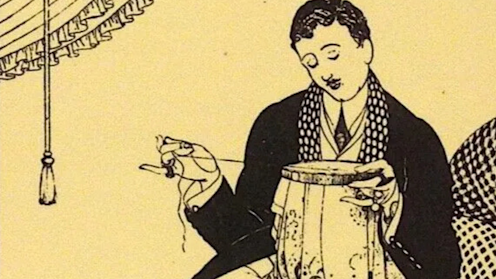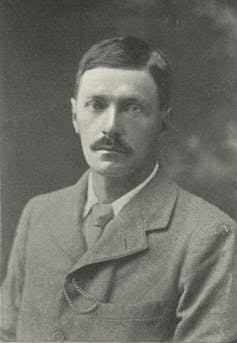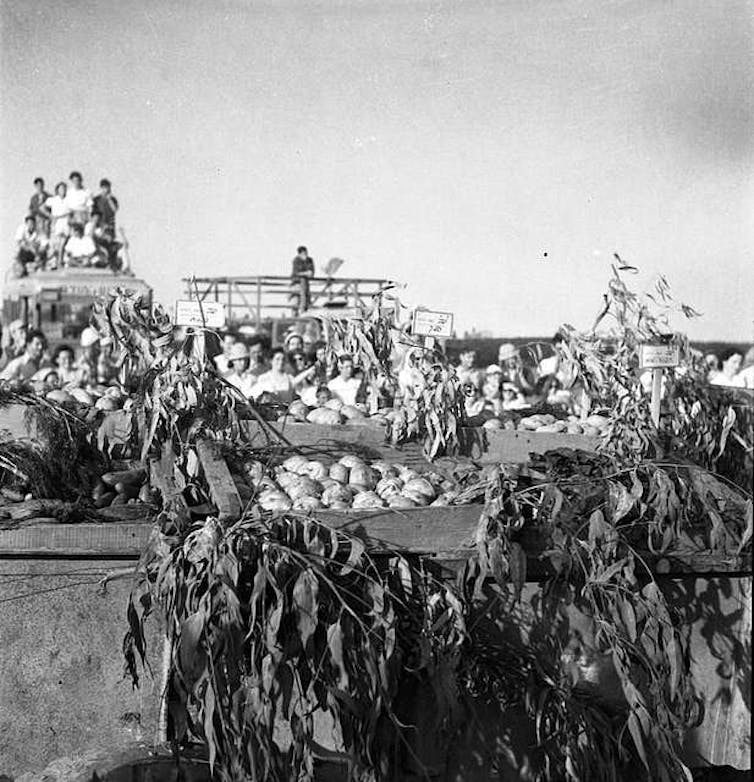Source: The Conversation – UK – By Sasha Garwood, Assistant Professor, University of Nottingham

In 1915, Edward Frederic (E.F.) Benson – the future bestselling author of comic novel series Mapp and Lucia – was in his late 40s, popular and famously charming. Since adolescence he’d been drawn to men, and his diaries recount passionate romances at Marlborough College and King’s College Cambridge. But, perhaps unsurprisingly for the son of an Archbishop of Canterbury, he was discreet.
George Wolfe Plank was 15 years younger – a scrappy, self-taught American artist whose fantastical Vogue covers defined the look of the era. George had a studio around the corner from Fred in Chelsea and an eye for his handsome neighbour.
For five years they shared houses and holidays – a couple to those who saw clearly, simply “bosom friends” to those who chose not to. The pair inhabited the tensions of queer masculinity in a world where sex between men was illegal and policed.
I found their story while exploring Fred’s schoolboy romance, David Blaize. Until I came across their letters, I didn’t know how important George had been for Fred, or vice versa. Most biographers mention a friendship or, occasionally, unrequited feelings.

Wikimedia
They met in 1915 after George wrote to Fred, calling him “unmarried, worldly and witty” – all coded queer signifiers at the time – and quoting the poet Walt Whitman, whose rhetoric about comrades and love was a touchstone for many men who desired men. It’s the most blatant approach I’ve found in the archives.
Fred invited him to tea and played him Tchaikovsky. Before long they were seeing each other every day, and George told his sister Amy that “I am … so happy I can scarcely realise it is I”.
Their contrasting backgrounds brought conflict and fascination, perhaps bridged by physical attraction. In one letter George declares:
Two people never came from such opposite poles and were better friends; He was born an aristocrat, lived at Lambeth Palace, educated … he goes in for all sorts of sport, which of course makes him a fine physical specimen – and yet, we seem to fit perfectly, which is a miracle!
Fred would drop into George’s studio after evening engagements. Were they sleeping together? Surviving scraps are suggestive, but the archive’s silence here is ambiguous. Letters tell us about love but, for safety, much less about sex.
Regardless, they were very close. When Fred bought 25 Brompton Square in London later that year, he insisted George move in too, and they decorated it together. “I grow fonder of him every day,” wrote George. For Fred, these were “a delight”, “halcyon days”.
They also rented Lamb House in Rye, East Sussex, together, with George saying that he wanted to “stay on here … for always”.
In 1916, they published The Freaks of Mayfair together, with George’s elegant Aubrey Beardsley-esque drawings illustrating Fred’s sharp social satires. This book put queerness at the heart of high society, particularly through the character of maiden-auntish character Aunt Georgie and his preference for “slightly effeminate young men”.
These years saw some notably queer works from Fred – David Blaize, Up and Down – and his first volume of autobiography. George produced Vogue covers, fashion illustrations and theatre scenery with dedication and flair.
Their surviving letters are loving and haunting. Fred burnt piles of correspondence before he died, fearing “mischief” – but his surviving writing to George is poignant.

“This scrawl must go: it carries with it a great many wishes that you were not away, and when the telephone bell rings, I miss your voice,” one letter from Fred reads. “The point is, I wish you were here … I want you.” George is caring, reassuring: “bestest love” and “I thought of you with every step”. Longing drifts from the pages.
Nevertheless, there was sometimes trouble. Fred could be depressive and George wrote, wryly, during a bad patch: “Poor Fred is a mass of nerves … I must look after him as much as he will let me … But he is a queer fish at times and it is hard work.”
When Fred’s mother died in 1918, George rushed to be with him. But having been swept off his feet by this glamorous, successful older man, he now spent months supporting a grieving companion who seemed suddenly old, both needy and unable to say what he needed.
Fred was “huffy” when George’s friends Mildred and Jimmy took him to Paris, upset when George travelled alone, and wanted more of his time than George felt was compatible with his work. Throughout 1920 they were together regularly, indulging in the “perpetual privacy” of Rye.
And then, in 1921, Fred disappears from George’s letters almost entirely.
So often it’s the unknowns that haunt us. What happened? The archives can’t tell us for certain. They were both generous, gregarious, caring – but it seems that Fred’s demands came to strain George’s kindness, unlike the blissful early days when Fred was happy and George dazzled.
One 1922 letter from Fred survives, its yearning subsumed and sad. Something had changed – Fred’s health maybe (rheumatism brought constant pain) but something else too.
In 1923, George’s friend HD (also queer, like many of their friends) told him: “I know you have been through something, have had some sort of psychic wound.” Fred is silent until Final Edition, a reflective autobiography finished ten days before his death, in which “a very intimate friend of mine … an artist of whimsical and imaginative work” makes Lamb House home.
These men might have lived in a different age, but their story is so familiar: love and grief and money and class, the tension between masculinity and vulnerability. And there are many such stories: queer love and loss buried in the archives, hiding in plain sight. Finding them feels both heartbreaking and heartening. Perhaps, whatever happens, what survives of us is love.
Looking for something good? Cut through the noise with a carefully curated selection of the latest releases, live events and exhibitions, straight to your inbox every fortnight, on Fridays. Sign up here.
![]()
Sasha Garwood does not work for, consult, own shares in or receive funding from any company or organisation that would benefit from this article, and has disclosed no relevant affiliations beyond their academic appointment.
– ref. The great unknown romance of writer E.F. Benson’s life – Fred and George, a love story hidden in letters – https://theconversation.com/the-great-unknown-romance-of-writer-e-f-bensons-life-fred-and-george-a-love-story-hidden-in-letters-262745









